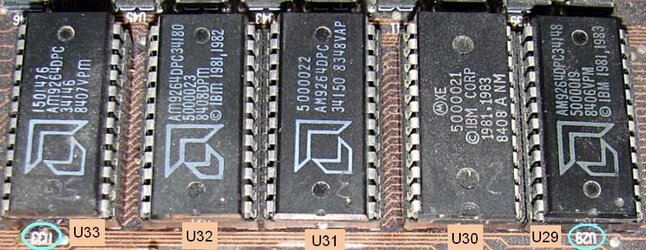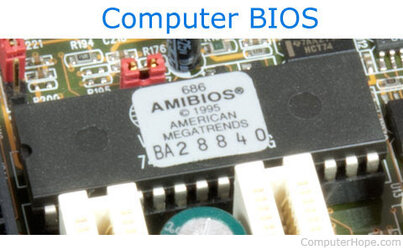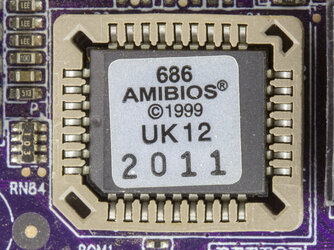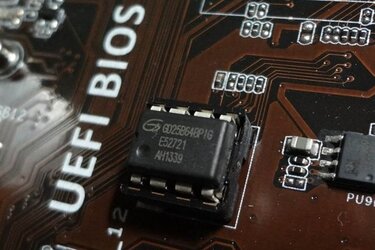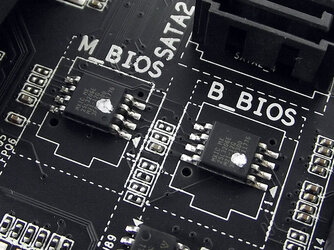- Joined
- Dec 6, 2010
-
Welcome to Overclockers Forums! Join us to reply in threads, receive reduced ads, and to customize your site experience!
You are using an out of date browser. It may not display this or other websites correctly.
You should upgrade or use an alternative browser.
You should upgrade or use an alternative browser.
BIOS Past and Present
- Thread starter WhitehawkEQ
- Start date
- Joined
- Apr 30, 2006
- Location
- United States
That is really cool.
Here is the 4MB BIOS from the initial release of the ASUS A7N8X Deluxe motherboard in November 2002. Since the BIOS is in a socket some people said they were able to revive a bricked motherboard by hot swapping a BIOS chip from a good motherboard. The ASUS A7N8X Deluxe motherboard is notable in that it is either the first or one of the first motherboard that supported dual-channel RAM.

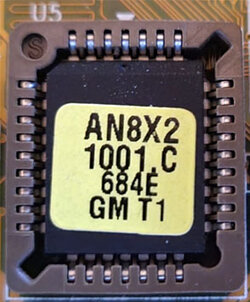
IIRC, that's was an nforce2 chipset which most boards supported dual channel ram in that gen.ASUS A7N8X Deluxe motherboard is notable in that it is either the first or one of the first motherboard that supported dual-channel RAM.
... since we're in a random history thread, dual channel ram has been around for decades (60s).
- Joined
- Jan 13, 2005
wonder what the specs for the first set of dual chanel is
any way, i dont see any ceramic chips. I remember having a few really old systems with windowed ceramic eproms for bios.
wonder if i still have that system...
moving sucks by the way, you can never remember if you got rid of something for the move or still have it
any way, i dont see any ceramic chips. I remember having a few really old systems with windowed ceramic eproms for bios.
wonder if i still have that system...
moving sucks by the way, you can never remember if you got rid of something for the move or still have it
I know what I have/don't... but WHERE it's located NOW, in the new place, is my problem..moving sucks by the way, you can never remember if you got rid of something for the move or still have it

- Joined
- Feb 1, 2011
- Location
- Republic of Texas
Don't know about Hot Swapping but I do recall on MBs from the '80s, early '90s had a socketed BIOS and had swapped several over that time. The trick was to not bend the pins as they would only bend a little before shearing off at the base.
- Joined
- May 15, 2006
I fixed a bricked motherboard after a failed BIOS update by hot swapping this chip. Don't remember what board it was. I put floss under the chip to cleanly pull it out while it was running.Here is the 4MB BIOS from the initial release of the ASUS A7N8X Deluxe motherboard in November 2002. Since the BIOS is in a socket some people said they were able to revive a bricked motherboard by hot swapping a BIOS chip from a good motherboard. The ASUS A7N8X Deluxe motherboard is notable in that it is either the first or one of the first motherboard that supported dual-channel RAM.
View attachment 358541
While it is true that dual-channel memory controllers have been around for over twenty years, it was only available in servers and high-end workstations. The ASUS A7N8X Deluxe was the first mainstream PC motherboard to offer this support in November 2002. The lower cost ASUS A7N8X motherboard did not support it. Today the memory controller is included in the CPU itself. Back then the dual-channel memory controller was part of the nForce2 chipset. The CPU I have is a AMD Athlon XP2800+. It is notable that dual-channel memory kits which include matched sets of memory sticks did not exist back then. The ASUS A7N8X Deluxe motherboard was very picky about RAM so it was hit or miss finding compatible RAM that worked in dual-channel. I lucked out that the 2 sticks of Corsair XMS RAM I bought worked in dual-channel mode. However, it was expensive at $378 for 1GB of RAM.IIRC, that's was an nforce2 chipset which most boards supported dual channel ram in that gen.
... since we're in a random history thread, dual channel ram has been around for decades (60s).
Because of the problem people were having finding compatible RAM manufacturers started hand testing pairs of RAM. They sold these as compatible with dual-channel memory controllers. Later they automated the process and started selling dual-channel memory kits.
Intel not to be left out started developing dual-channel for the mainstream PCs and launched motherboards supporting this the following year.
In 2003, Intel Corporation decided to launch a new motherboard architecture utilizing dualchannel memory into the mainstream computer market. Up until this point, all Intel-based mainstream computers were only available with single-channel memory. The number of memory channels has a significant effect on a computer's overall performance. The GHz number is no longer the sole criterion for determining system performance. Dual-channel memory has been used for many years in higher-performing systems such as servers and workstations and is quickly becoming a part of mainstream computing.
Intel Dual-Channel DDR Memory Architecture
Intel Dual-Channel DDR Memory Architecture
Today, buying a computer is becoming a more complicated process where potential buyers are inundated with technical terms like GHz, DDR, FSB, Dual-Channel, and Hyper-Threading. Traditionally, the GHz (Gigahertz) number, indicating processor speeds, has always been one of the key factors in any...
Right. So any boards using that chipset also support it (though not all). Didn't a slew of boards release on a specific day (similar today's launches) so any launched that day would be a first?Back then the dual-channel memory controller was part of the nForce2 chipset.
Intel's dual-channel arch came out later, indeedereeno! Not sure I count the 840 and RAMBUS in the late 90s..
The nForce2 chipset was released by Nvidia in July 2002. Several motherboards came out with this chipset but the ASUS A7N8X and ASUS A7N8X Deluxe were the first. When I preordered the AMD XP2800+ CPU from Newegg in October 2002 the ASUS A7N8X Deluxe was the only motherboard available that supported dual-channel.Right. So any boards using that chipset also support it (though not all). Didn't a slew of boards release on a specific day (similar today's launches) so any launched that day would be a first?
Intel's dual-channel arch came out later, indeedereeno! Not sure I count the 840 and RAMBUS in the late 90s..
I bought an ASUS A7V400-MX motherboard after that that has a VIA KM400A chipset. It supports the same CPUs as the ASUS A7N8X motherboard. However, it only has a single channel memory controller.
Tests with the ASUS A7N8X Deluxe motherboard showed marginal speed improvements using dual-channel memory. Was Nvidia just ahead of its time or was it only a marketing ploy?
Twenty years ago there were 2 or 3 companies that made chipsets for AMD CPUs. AMD made devvelopment chipsets only and didn't sell any them to the public. I think when AMD bought Nvidia's competitor ATI things soured with Nvidia. It wasn't long before AMD was forced to develop and sell their own chipsets.
Last edited:
- Joined
- Apr 30, 2006
- Location
- United States
I have one stick of rambus with a blue heatsink somewhere.
Similar threads
- Replies
- 55
- Views
- 5K
